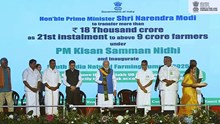
India has no shortage of food. We grow enough grains to feed more than a billion people. Yet, we remain one of the most undernourished populations in the world.
This paradox is rooted in what scientists call "hidden hunger" - a widespread lack of essential micronutrients like iron, zinc, protein, and vitamin A. It doesn't look like hunger. There are no empty plates. But there are generations growing up with low immunity, chronic fatigue, poor learning outcomes, and in far too many cases, lifelong health risks.
The food is present. But the nutrition is missing.
The Decline of Nutrient Density in Staples
Over the last few decades, India's agricultural focus has been squarely on increasing yield growing more from less. And while that helped avert famine and food shortages, it came at a steep nutritional cost.
The soil degraded. The seed quality narrowed. As a result, modern staples like wheat, rice, and pulses - the backbone of the Indian diet, began losing their natural mineral content. Studies show that iron, zinc, and protein levels in many of today's staple varieties are 50-70% lower than traditional varieties. A roti today simply isn't what it used to be.
Supplements, Multigrain & Fortification: Partial Answers, Uneven Impact
To fill the gap, the market offered fixes - multigrain flours, organic labels, fortified foods, and synthetic supplements. But each came with tradeoffs.
Multigrain a buzzword, but not a solution.
What began as a sensible idea - using diverse grains for diverse nutrients - has turned into a marketing gimmick. Today's multigrain flours often pack five, seven, even nine different grains into a single mix. The problem? The digestive system isn't built to absorb such a variety of complex grains in one meal.
Too many grains can actually reduce nutrient absorption, overload digestion, and lead to discomfort. The bioavailability of key minerals like iron and zinc often drops when antinutrients (like phytates or tannins from one grain) interfere with another.
That's why nutritionists now argue: one grain at a time, done right, is better than nine confused in a packet.
A well-grown, biofortified single grain, like iron-rich pearl millet or zinc-rich wheat - offers far better nutrition, better digestion, and a cleaner, more absorbable food experience than most multigrain mixes.
Organic foods avoid chemical inputs a welcome step, but don't necessarily offer higher nutrition. A pesticide-free grain is still nutritionally hollow if the soil it grew in is depleted.
Artificial fortification, meanwhile, became the go-to policy and industry solution - adding lab-made nutrients after processing. But this process can be unstable, poorly absorbed by the body, and increasingly rejected by consumers seeking cleaner, natural food.
Finally, supplements, from pills to powders, treat nutrition like medicine: isolated, external, and expensive.
Biofortification: Nutrition Rebuilt from the Root
Biofortification offers a different path.
It doesn't add nutrients after harvest. It builds them in, through smarter seed breeding and mineral-aware farming. These crops - whether wheat, millet, or pulses - draw more iron, zinc, and protein from the soil and hold onto it.
They don't need additives. They don't need repackaging. They just need to be grown right.
Some zinc-rich wheat varieties now offer up to 40 ppm zinc, while improved millets provide over 70 ppm iron. These gains are not theoretical - they're visible in the grain, measurable at the lab, and impactful in the body.
It's food that feeds better. Food that carries its own weight.
A Scalable Solution, Hiding in Plain Sight
Across India, farmers are starting to adopt biofortified seeds. In rural belts, improved varieties are making their way into school mid-day meals and community rations. In cities, consumers are beginning to spot them on shelves - sometimes marked as "iron-rich atta" or "high-zinc rice." They don't carry big banners. But they carry real nutrition.
This is the power of biofortification - it doesn't ask for new habits. It fits into old ones. You still eat the roti. You still make the khichdi. Only now, it nourishes the way it was always meant to.
The Role of the Consumer
For this movement to grow, farmers need markets. And that's where each of us comes in.
When you go to platforms like Blinkit, Swiggy Instamart, or Flipkart, look for biofortified atta or rice. Some brands now clearly mention iron-rich or zinc-rich staples. By choosing these over regular ones, you're not just making a better choice for your family - you're supporting a food system that rewards natural nutrition over artificial fixes.
You're voting - with your wallet - for food that heals instead of just fills.
Conclusion: A Better Kind of Staple
Biofortification isn't a health trend. It's not a marketing gimmick. It's the quiet reinvention of food itself, where the grain becomes the supplement, and the soil becomes the solution.
In a country where 70% of calories still come from staples, it offers a practical, scalable, and powerful answer to our nutrition crisis. It doesn't ask us to change what we eat - just how we grow it.
As consumers, it's time we stop outsourcing our nutrition to pills and powders. The future lies not in factories, but in fields. Not in what's added to food, but what food already contains.
It's time we returned to real nourishment - grown, not manufactured.
















